B0041VYHGW EBOK (152 page)
Authors: David Bordwell,Kristin Thompson

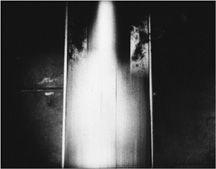
10.65 … a strongly vertical one.
The familiar alternating circle and triangle return, but with differences: now the triangle is sometimes upside down, and each shape remains on the screen slightly longer. The segment continues with more spinning shiny objects and machine parts; then it reintroduces the motif of the woman’s masked eye (similar to
10.60
). Now the motions of this eye are compared to machine parts.
Segment 4
closes with one of
Ballet mécanique
’s most famous and daring moments. After a shot of a rotating machine part
(
10.66
),
we see 7 identically repeated shots of a laundry woman climbing a stair and gesturing
(
10.67
).
The segment returns to the smiling mouth, then gives us 11 more repetitions of the same shot of the laundry woman, a shot of a large piston, and 5 more repetitions of the laundry woman shot. This insistent repetition makes the woman’s movements as precise as those of the machine. Even though she is seen in a real place, we cannot see her as a character but must concentrate on her movements’ rhythms.
Segment 4
is quite different from earlier ones, but it does bring back motifs: The prism recurs briefly (from
segment 2
), spinning shiny objects recall those of
segment 3
, and the woman’s eyes and mouth (
segments 1
and
2
) return, having been absent from
segment 3
.
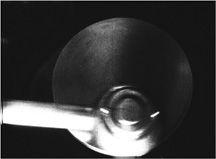
10.66
Ballet mécanique
cuts from a machine part …
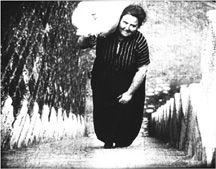
10.67 … to mechanical repetitions of a woman’s movements.
Segment 4
has been the culmination of the film’s comparison of mechanical objects with people. Now segment 5 introduces a strong contrast by concentrating on printed intertitles. Unlike other segments, this one begins with a black screen, which is gradually revealed to be a dark card on which a white zero is painted.
Unexpectedly, an intertitle appears: “
ON A VOLÉ UN COLLIER DE PERLES DE 5 MILLIONS
” (“A pearl necklace worth 5 million has been stolen”). In a narrative film, this might give us story information, but the filmmakers use the printed language as one more visual motif for rhythmic variation. There follows a series of quick shots, with large zeros, sometimes one, sometimes three, appearing and disappearing, shrinking and growing. Parts of the intertitle appear in isolation (“on a volé”), participating in this dance of letters. The film plays with an ambiguity: Is the zero really an “0,” the first letter of the sentence? Or is it part of the number 5,000,000? Or is it a stylized representation of the pearl necklace itself? Beyond this sort of play with a visual pun, the zero recalls and varies the circle motif that has been so prominent in the film.
More punning occurs as the zero gives way to a picture of a horse collar—which resembles the zero visually but also refers to the word
collier
(which in French can mean either “necklace” or “collar”). Editing makes the collar bob about in its own little dance (
10.55
) and alternate with moving zeros and parts of the intertitle sentence, sometimes printed backward—to emphasize their graphic, rather than informative, function. This segment has been very different from earlier ones, but even here a couple of motifs are repeated. Just before the horse collar is introduced, we see the masked woman’s eye briefly, and, in the course of the rapid flashes of intertitles, one tiny shot of a machine part is inserted.
After this point, the film moves toward variations that are closer to the elements of the opening segments. Segment 6 shows us rhythmic movements involving mostly circular shapes
(
10.68
,
10.69
).
Once again the comparison of person and object comes forward. An abstract circular shape grows, cueing us to watch for the recurrence of this shape. A woman’s face appears in a prismed view; she passes a piece of cardboard with holes cut in it before her face, with her expression continually changing in a mechanical fashion. We see the circles and triangles alternate again, but this time in four different sizes. A quick series of shots of rows of shiny kitchen utensils follows
(
10.70
),
with short bursts of black film interspersed. This blackness picks up and varies the dark backgrounds of the intertitles in segment 5, and the shiny pots and other utensils reintroduce a motif that has appeared in every segment
except
5. The motif of rows of objects had come in
segment 3
, while the swinging motion of the utensils in many of these shots echoes the swinging of the woman and the shiny ball from way back in
segment 1
.
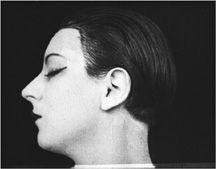
10.68
Ballet mécanique
’s series of circular shapes begins with a woman’s head, eyes closed, turning …
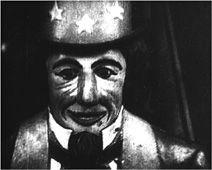
10.69 … after which we see a statue swing toward and away from the camera.
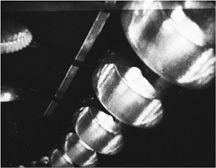
10.70
Ballet mécanique:
a brief shot of kitchen utensils.
Segment 7 continues the turn back to the beginning. It begins with a shot of a display window
(
10.71
).
The circle motif returns, leading into a set of dances that vary key motifs. Very rapid editing makes a pair of mannequin legs dance
(
10.72
)
; then the legs start to spin within the shots. The shiny ball motif returns, but now two balls spin in opposite directions. Then a hat and a shoe alternate quickly
(
10.73
),
and the editing creates a startlingly abstract effect. At first, we see the different shapes distinctly, but as the brief shots continue to alternate, we notice variations. The hat changes position, and sometimes the shoe points in one direction, sometimes the other. The cutting rhythm accelerates, and the shots become so short that we see only a single white object pulsating, morphing from circle to lozenge and back again. The filmmakers use the graphic contrasts they’ve created to make us aware of apparent motion, our tendency to see movement in a series of slightly different still pictures. This is one process that makes cinema itself possible. (See
Chapter 1
.)
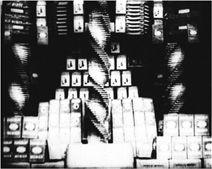
10.71 In
Ballet mécanique,
spiral shapes seem to freeze the gyrating motions that have made up so much of the film.

10.72 In
Ballet mécanique,
very short shots make mannequin legs “dance.”
